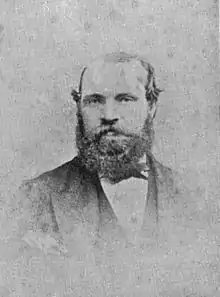Thomas Savin
Thomas Savin (1826 – 23 July 1889) was a British railway engineer who was the contractor who built many railways in Wales and the Welsh borders from 1857 to 1866. He also in some cases was an investor in such schemes.
Thomas Savin | |
|---|---|
 | |
| Died | 23 July 1889 (aged 62–63) Oswestry, Shropshire, England, United Kingdom |
Early life
Savin was born in Shropshire at Llwynymaen near Oswestry in 1826.[1] He married in 1852 Eliza Hughes with whom he had two sons who survived him. He initially worked in Oswestry running a mercery business in partnership with Edward Morris, who subsequently purchased then sold the Van lead mines.[2]
Railway contractor
In 1857 Savin formed a partnership with David Davies to build the Vale of Clwyd Railway. The partnership was the principal contractor for many of the lines that became the Cambrian Railways.[1] The partnership was dissolved in 1860.[3] He also had an interest in or worked on a number of secondary and minor railways, including the Brecon and Merthyr Tydfil Junction Railway, the Hereford, Hay and Brecon Railway, the narrow gauge Corris Railway, the Kington & Eardisley Railway[4] and the Bishop's Castle Railway.[5]
Savin's bankruptcy in 1866 led to the stalling of the Aberystwith and Welsh Coast Railway, which became a part of the Cambrian Railways.
Industry
Savin owned a number of industrial companies across Wales. He was the owner of the Cooper's Lime Rocks limestone quarry at Porthywaen in 1872, which suffered from a significant accident. Kegs of gunpowder were hauled up the incline to the magazine in the quarry. As the most recent set of kegs were being moved into the magazine, an empty wagon broke loose and collided at high speed with one of the kegs. The resulting explosion killed six workers employed by Savin.[6]
Politics and other interests
David Davies had entered active politics in 1865 when he unsuccessfully fought at Cardiganshire in the General Election. Later that year Savin was briefly mentioned as a possible Liberal candidate for Brecon.[7] Savin served in local politics in Oswestry, to whose borough council he was elected in 1856, became Mayor of the town in 1866, and was alderman from 1871 until his death. He left the Liberal party and became a Conservative because of his support for Benjamin Disraeli's stance over Bulgaria and Turkey against Russia in the 1870s.[2]
Savin served in the volunteer force as lieutenant in the Montgomeryshire Rifles and was captain of the 15th (Oswestry) company of the Shropshire Rifle Volunteers in 1864. He was also a Fellow of the Royal Horticultural Society and Associate of the Institution of Civil Engineers.[2]
Later life
Savin died at his home, Ivy House, in Salop Road, Oswestry on 23 July 1889 and was buried in Oswestry Cemetery, aged 63, on 26 July (Section D, Grave 34).[8]
References
- "Biographies of chairmen, managers & other senior railway officers". STEAMINDEX. Retrieved 19 February 2018.
- "Oswestry. Death of Mr. Thomas Savin". Shrewsbury Chronicle. 26 July 1889. p. 7.
- "No. 22525". The London Gazette. 2 July 1861. p. 2751.
- Greene, Miranda (2003). "The Kington and Eardisley railway". Hereforshire Council - Herefordshire Through Time. Retrieved 20 February 2018.
- Oppitz, Leslie (March 2005). "The Bishop's Castle Railway". BBC. Retrieved 20 February 2018.
- "Fearful Gunpowder Explosion at the Porthywaen Lime Works". The Cambrian News. 7 June 1872. p. 6.
- "Editorial". Welshman. 6 October 1865. Retrieved 24 November 2014.
- "Savin, Thomas". Oswestry Cemetery Project. Retrieved 20 February 2018.
Bibliography
- Gasquoine, C. P.; The Story of the Cambrian – a biography of a railway; Woodall, Minshall, Thomas & Co, 1922
- Johnson, Peter; An Illustrated History of the Great Western Narrow Gauge; Oxford Publishing Co, 2011 (Savin's involvement with the Corris Railway)
- Williams, Herbert; Davies the Ocean – railway king and coal tycoon; University of Wales Press, 1991
